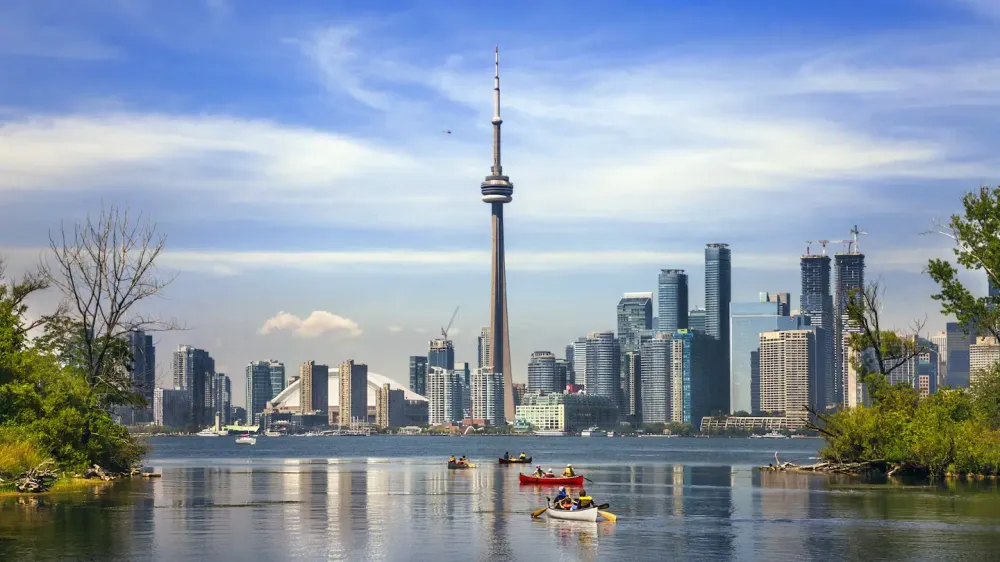23 Off-The-Radar Things To Do In Ontario (2025)
Ontario is a megacity in every sense of it. However, it takes on a second form with its natural landmarks and unspoken beauty. When I was told I could start my morning in a global megacity, hearing a dozen languages on a single block, and end my day in a lakeside cabin surrounded by nothing but pines, it was hard to believe.
Yet, that was exactly what happened, and Ontario has made its way to the list of cities I will definitely revisit.
Here are a few interesting things to do in Ontario when you visit.
1. Ontario Mills
Important Information
- Address: 1 Mills Circle, Ontario, CA 91764 (Note: This is in California, not Ontario Canada — ensure you mean the correct “Ontario”).
- Parking: Large on-site parking lot; free parking available.
- Accessibility / Facilities: Indoor climate-controlled mall, over 200 stores, dining & entertainment options.
- Opening/Closing Time: Varies by store; mall core hours around 10:00 am – 8:00 pm typical.
- Distance to City Centre: If you mean this mall, it’s located in Ontario, California (so check your routing).
- Type of Experience: Large outlet & mall shopping destination, good for brands, bargains and indoor browsing.
- Special Notes: Best visited on weekdays to avoid heavy crowds; indoor setting good for any weather.
- Family Friendly?: Yes — suitable for families, groups and all ages.
- Insider Tip: Check store directories ahead of time and aim for earlier in day for easier parking and quieter browsing.
- Why Good for Your Guide: Adds a strong retail/urban contrast to nature- and culture-based stops.
Ontario Mills is a major retail and entertainment destination, offering visitors a broad mix of shopping, dining, and leisure options under one roof. With more than 200 stores, including well-known outlets and designer brands, it appeals to both casual shoppers and those seeking specific deals. The center also features a 30-screen AMC Theatres megaplex, making it a convenient spot to combine a day of shopping with entertainment.

Among the popular tourist places, Ontario Mills stands out for its size, variety, and accessibility. In addition to shopping and movies, visitors can find a diverse range of restaurants, from quick bites to full-service dining. Its proximity to major highways and Ontario International Airport also makes it an easy stop for travelers passing through the region.
⭐⭐⭐⭐⭐ - Matthew West
This is one of the coolest mall experiences you'll ever have in Southern California. This mall is an experience and really makes the Inland Empire shine. Great food great shopping all around great experience. The parking is plentiful and so are the choices of food. There are many restaurants around the mall to choose from but the food court is really good too. The Cajun Grill, auntie Anne's pretzels. Hot dog on a Stick are all so good. 10/10 mall
2. CN Tower
Important Information
- Address: In downtown Toronto, Ontario, Canada. (Exact street found on official site.)
- Parking: Several downtown Toronto parking garages; you’ll likely park off-site and walk/public transit.
- Accessibility / Facilities: Observation decks (Main & Lower) at ~346 m, glass floor, outdoor terrace, dining at the 360 Restaurant.
- Opening/Closing Time: Timed admission tickets required; hours vary by day.
- Distance to City Centre: It is in the city centre of Toronto.
- Type of Experience: Iconic landmark offering panoramic views, dining, high-altitude thrills.
- Special Notes: On a clear day you can see as far as 100 km.
- Family Friendly?: Yes — but note height/edge aspects may be intimidating for some.
- Insider Tip: Book a sunset viewing for spectacular colours and fewer crowds.
- Why Good for Your Guide: A must-see urban landmark; strong visual impact and memorable travel content.
The CN Tower isn’t just Toronto’s most recognizable landmark, it’s the city’s entire sense of scale made visible. Rising 553 meters over the skyline, it was once the tallest freestanding structure in the world, built in the 1970s as a demonstration of Canadian engineering strength. Today, it’s a symbol of modern Toronto: multicultural, ambitious, and constantly looking upward.
The tower’s glass-floor observation deck is the classic experience, giving visitors a thrilling view straight down to the streets below, while the SkyPod lifts you even higher for sweeping panoramas of Lake Ontario and the distant Niagara region. At night, its LED lights shift with seasons, holidays, and local celebrations, turning the tower into a vertical beacon for the entire city.
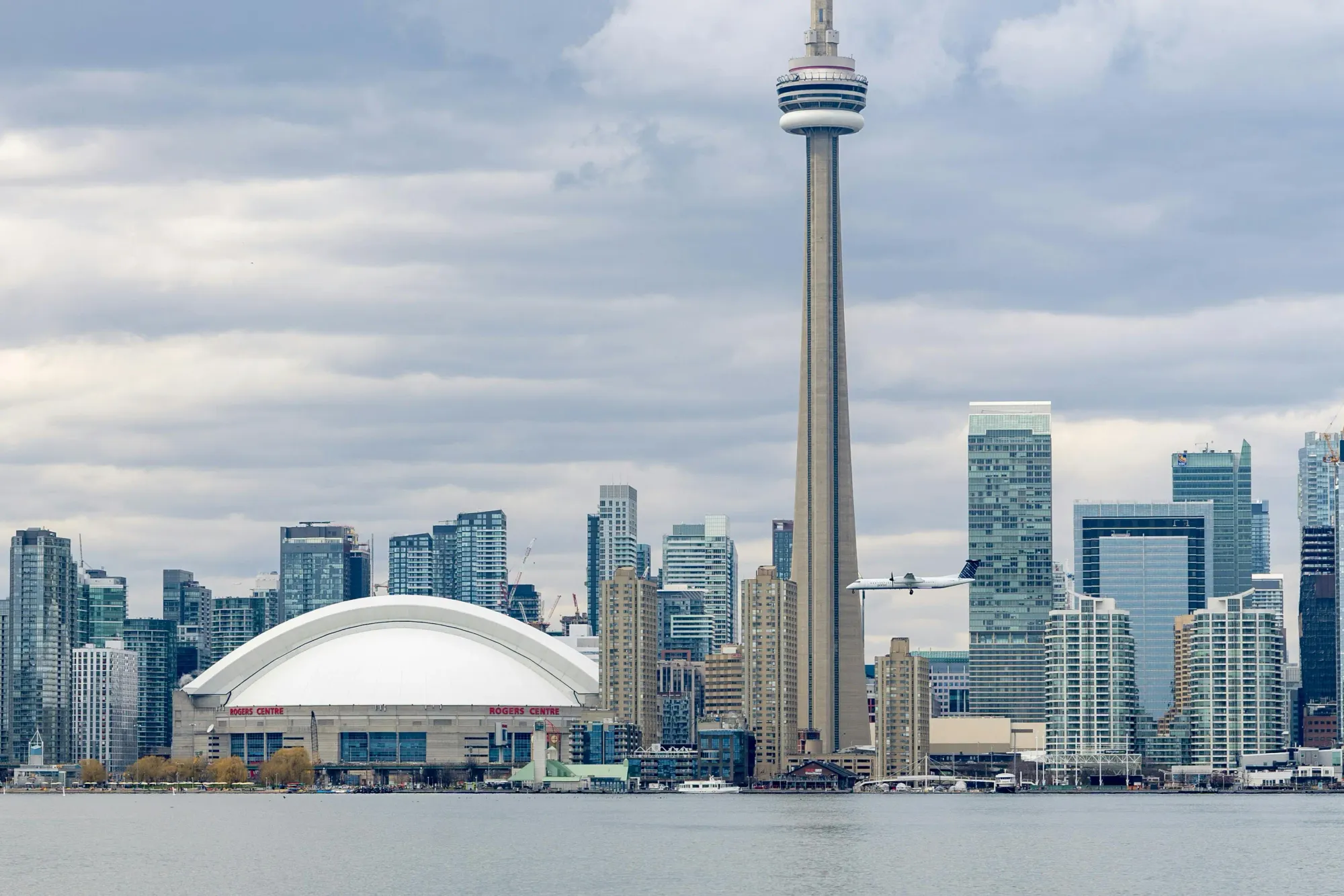
⭐⭐⭐⭐⭐ - Stephan Strecker
Amazing experience at the CN Tower! The view is absolutely breathtaking — you can see the entire city and beyond. The atmosphere is relaxed yet exciting, and everything is super well organized. Perfect spot for photos, sunsets, or just taking in the beauty from above. Totally worth the visit — a must-see for anyone in town!
3. Niagara Falls
Important Information
- Address/General: Niagara Falls, Ontario, Canada — world-famous waterfalls at the border of the US and Canada.
- Parking: Multiple visitor parking lots near falls, but expect busy traffic especially in peak seasons.
- Accessibility / Facilities: Walkways, lookout points, tours; accessible paths available though some terrain may be steep/slippery.
- Opening/Closing Time: Open year-round, day and evening; special events and illumination at night.
- Distance to City Centre: The falls themselves are in the city of Niagara Falls.
- Type of Experience: Natural wonder and major attraction — stunning scenery, photo opportunities, boat tours.
- Special Notes: Popular destination — plan for crowds, especially around the brink and lookout points.
- Family Friendly?: Yes — good for all ages though safety near edges and wet surfaces is important.
- Insider Tip: Visit early morning or later evening to avoid crowds; bring waterproof gear if doing a boat tour.
- Why Good for Your Guide: Iconic natural landmark; essential for any Ontario travel story.
The sheer scale and force of the Horseshoe Falls make Niagara Falls a natural spectacle that only a few places in the world can match. From the main observation points, visitors can experience the full impact of the falls’ thunderous descent, often with mist rising high into the air on sunny days.
Beyond viewing platforms, there are several ways to experience the falls more intimately. The Hornblower Niagara Cruises take visitors directly into the mist at the base of the Horseshoe Falls, offering a closer perspective. Journey Behind the Falls offers tunnels and platforms that allow you to see the power of the water from beneath. Nearby, Clifton Hill provides dining, entertainment, and family-friendly activities, making it easy to extend your stay.

For those interested in more Niagara Falls, the Butterfly Conservatory, the Niagara Parks Botanical Gardens, and the historic town of Niagara-on-the-Lake are short drives away. Each offers a quieter, more relaxed side of the region. With its combination of natural wonder and well-developed visitor amenities, Niagara Falls continues to be a destination that balances spectacle with accessibility for all types of travelers.
⭐⭐⭐⭐⭐ - Teresa Such
Absolutely stunning, i highly recommend visiting once in your life time. We went during a weekday in September and it was not very crowded. Pretty east walk from one side of the falls to the other (about 30-45 min at a very leisurely pace and stopping for photos.)
4. Parliament Hill
Important Information
- Address: Wellington Street, downtown Ottawa, Ontario, Canada.
- Parking: Limited parking onsite; better to use downtown public lots or transit.
- Accessibility / Facilities: Guided tours free of charge; security screening required; historic buildings, gardens, lookout over Ottawa River.
- Opening/Closing Time: Open all year; tour schedules vary with parliamentary activity.
- Distance to City Centre: Located in the heart of Ottawa.
- Type of Experience: Political/historic landmark — visit of Canada’s seat of parliament and iconic architecture.
- Special Notes: While tours are free, they may need advance booking depending on season.
- Family Friendly?: Yes — educational and impressive for all ages.
- Insider Tip: Catch the Changing of the Guard ceremony in summer; combine with a walk along the Rideau Canal.
- Why Good for Your Guide: Supports cultural and civic dimension of Ontario; adds depth beyond nature and shopping.
Visiting Parliament Hill is a defining part of any trip to Canada's capital city. The complex, located on a scenic bluff overlooking the Ottawa River, houses the offices of the Prime Minister, members of Parliament, and the ceremonial spaces for Canada's federal government. It stands as a symbol of the country’s political history and democratic foundations.

Beyond this, Parliament Hill offers a compelling mix of history, architecture, and ceremony. Free guided tours take guests through the Centre Block (currently under renovation, with tours focused on temporary spaces), where you can learn about Canada's parliamentary system, view historic chambers, and admire intricate Gothic Revival details. In summer months, the Changing of the Guard ceremony on the front lawn is a well-loved tradition, featuring precision drills and live military music.
Throughout the year, Parliament Hill hosts special events including light shows, Canada Day celebrations, and seasonal displays. Walking paths along the river and adjacent green spaces also make it a good area to explore beyond the immediate historic buildings.
⭐⭐⭐⭐⭐ - Cecily Brown
Astounding. The buildings are massive. There's just no way to fully grasp how big these fabulous buildings are without seeing them in person. There was a lot of construction going on, but still worth going. I took the tour of the House of Commons. It was interesting, fun, and educational. Well worth the 40-45 minutes standing & walking. They have stools they provide for you to carry with you is you cannot stand that long. I used one, it was great, sturdy, easy to use & carry.
5. Algonquin Provincial Park
Important Information
- Location: Central Ontario, Canada — between Georgian Bay and Ottawa River; approximately 7,635 km².
- Parking / Access: Access points along Highway 60 and others; multiple parking lots at visitor centres and trailheads.
- Accessibility / Facilities: Visitor Centre, trails, canoe routes, camping, wildlife viewing, multi-season activities.
- Opening/Closing Time: Open year-round; facilities may have seasonal hours.
- Distance to Major Cities: Roughly 2–3 hours’ drive from Toronto; northeast of Toronto.
- Type of Experience: Wilderness, nature, paddling, hiking, wildlife — a hallmark of Canadian natural heritage.
- Special Notes: Recognised as historic site; mix of ecosystems; prime for canoe/camping adventures.
- Family Friendly?: Yes — especially for outdoor families, though some trails/routes may be remote or rugged.
- Insider Tip: Book campsites early in peak season; check wildlife safety (bears, moose). Visit early morning for best light and quiet.
- Why Good for Your Guide: Adds substantial nature and outdoor dimension; deeply resonant for storytelling in travel content.
Exploring Algonquin Provincial Park is a top choice for visitors in Ontario. Known for its rugged beauty, diverse ecosystems, and extensive network of canoe routes and hiking trails, the park offers a full immersion into Ontario’s natural landscape.
Visitors can choose from a wide variety of activities depending on the season. Spring and summer bring opportunities for backcountry canoeing, wildlife viewing, and hiking along trails like the Lookout Trail and Centennial Ridges Trail. Autumn transforms the park into a landscape of brilliant reds and oranges, attracting photographers and visitors keen to experience the foliage. In winter, snowshoeing and cross-country skiing open up quieter, more solitary views of frozen lakes and forested hills.
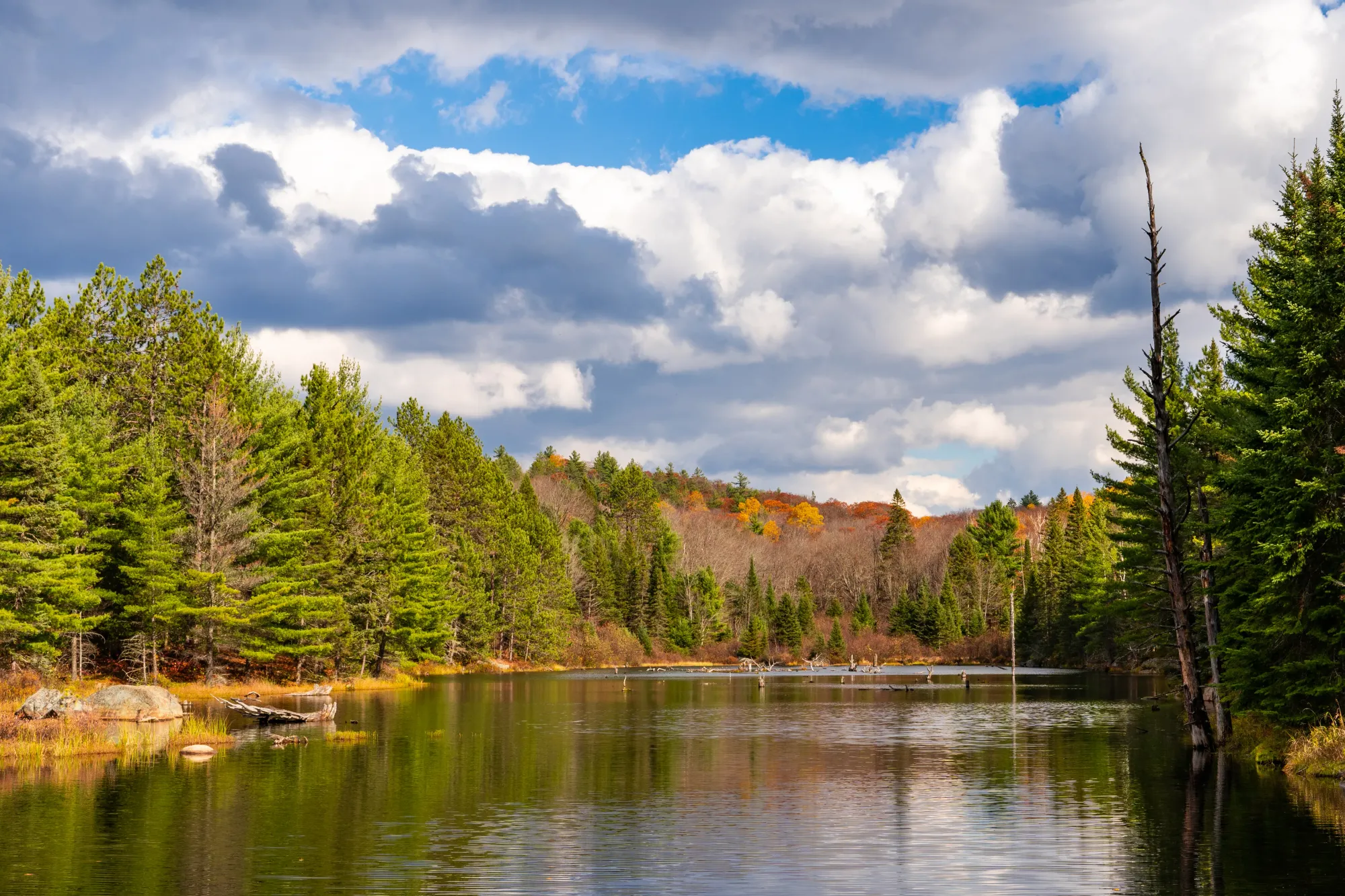
Algonquin is not only scenic but also rich in wildlife. Moose, beavers, black bears, and hundreds of bird species are commonly seen, particularly in early morning hours along water routes. Several visitor centers and interpretive trails provide historical and ecological insights into the park’s significance.
⭐⭐⭐⭐⭐ - Helena
One of the most beautiful places in Ontario. It’s pretty popular and famous for its fall colorful scenery. We drove about 300 km for one day camping in the park. Not only at our destination, but also along the way, we enjoy and explore the red and yellow mountains and forests, and blue and clear lakes. Love the splendid and vibrant nature! I took lots of photos and videos, sharing with my friends and you.
6. Stratford Festival
Important Information
- Address: Multiple venues, including Festival Theatre (55 Queen Street, Stratford, ON N5A 6V2)
- Parking: Street parking and public lots available near theatres; free evening parking after 6 pm in most areas
- Accessibility: Wheelchair-accessible seating, hearing-assist devices, and accessible restrooms available at all venues
- Opening/Closing Time: Annual season runs April–October; showtimes vary by production (matinees & evenings)
- Distance to City Centre: Venues are located throughout Stratford’s charming downtown
- Type of Experience: Canada’s premier repertory theatre festival — Shakespeare, classics, and contemporary plays
- Special Notes: Performances rotate daily; costumes and sets are internationally acclaimed
- Family Friendly?: Yes, depending on the play (some productions aimed at youth audiences)
- Insider Tip: Book early for Shakespeare classics; enjoy riverside picnics between shows
- Why Good for Your Guide: Highlights Ontario’s cultural sophistication and connection to the arts
The Stratford Festival is one of North America's most respected theatre events, drawing actors, directors, and audiences from across the globe. What began as a way to revive the local economy has grown into an internationally recognized celebration of Shakespearean and contemporary drama. Each year, from spring to fall, Stratford’s multiple venues offer a diverse program of plays ranging from classics to new Canadian works.
As one of the premier tourist attractions, the festival is more than just performances. The entire town embraces the spirit of the arts. Visitors can stroll along the Avon River, explore boutique shops, and dine at locally-owned restaurants that serve the steady stream of festivalgoers. The relaxed pace and walkable downtown make it easy to enjoy a full day or weekend centered around live theater.
While Shakespeare remains the festival’s cornerstone, modern productions, musicals, and experimental works make it accessible to a wide audience. The quality of production, from set design to acting, consistently matches the standards of much larger cities.
7. Thousand Islands
Important Information
- Address: Gananoque serves as the main gateway, located along the St. Lawrence River near Kingston
- Parking: Free and paid lots near boat cruise terminals and marinas
- Accessibility: Most town facilities and larger cruise boats are wheelchair accessible
- Opening/Closing Time: Best visited May–October; cruise operations typically 9 am – 6 pm
- Distance to City Centre: Gananoque is about 30 km east of Kingston (roughly 2.5 hours from Toronto)
- Type of Experience: Archipelago of over 1,800 islands — boat tours, kayaking, castles, and scenic lookouts
- Special Notes: Boldt Castle (U.S. side) requires passport for entry; sunset cruises are spectacular
- Family Friendly?: Yes — plenty of outdoor and water activities suitable for families
- Insider Tip: Visit mid-week for fewer crowds; combine with a picnic at Thousand Islands National Park
- Why Good for Your Guide: Combines nature, history, and photography — perfect for scenic storytelling
The Thousand Islands offer some of the most scenic water landscapes in Ontario, with countless opportunities for exploration by boat, kayak, or scenic cruise. Departing from Gananoque, boat tours weave through this network of lush islands, many home to historic mansions, lighthouses, and hidden coves. The area is a paradise for photographers, nature lovers, and anyone who enjoys being close to the water.
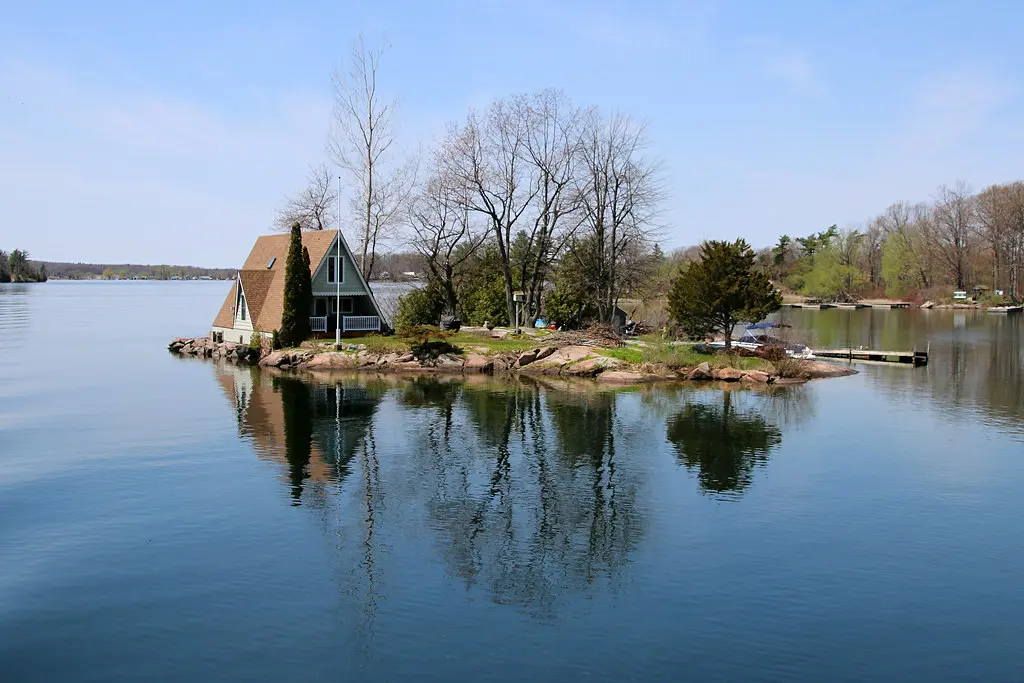
When thinking about places to visit in Ontario, the Thousand Islands stand out for combining natural beauty with rich cultural history. Some tours include a visit to Boldt Castle, a historic American mansion, while others focus on wildlife and the ecology of the St. Lawrence River.
Beyond water-based activities, Gananoque itself offers local dining, small museums, and theater performances at the Thousand Islands Playhouse. The region also appeals to cyclists and hikers, with trails running parallel to the shoreline.
8. Science North
Important Information
- Address: 100 Ramsay Lake Road, Sudbury, ON P3E 5S9
- Parking: Large on-site paid lot with accessible spaces
- Accessibility: Fully wheelchair accessible; sensory-friendly options and tactile exhibits available
- Opening/Closing Time: Typically 10 am – 5 pm daily; evening hours during special events
- Distance to City Centre: Around 3 km from downtown Sudbury
- Type of Experience: Interactive science museum with IMAX theatre, planetarium, and live animal exhibits
- Special Notes: Includes Northern Ontario’s most advanced science education centre and butterfly gallery
- Family Friendly?: Absolutely — built for children and curious adults alike
- Insider Tip: Allow at least half a day to explore; combo tickets available with Dynamic Earth museum
- Why Good for Your Guide: Adds educational and family-interactive content; ideal balance to nature trips
Science North is a leading science education centre offering an engaging, interactive experience that appeals to both adults and children. Exhibits cover a wide range of topics, including geology, environmental science, health, and innovation, making it a versatile destination for learning and exploration. Its unique architecture, featuring two snowflake-shaped buildings linked by a rock tunnel, reflects the dramatic natural landscape of Northern Ontario.

Permanent features include live animal exhibits, an IMAX theatre, and hands-on displays related to mining and space sciences. Science North also offers seasonal special exhibitions and a planetarium, ensuring that repeat visitors find something new each time.
The center's location beside Ramsey Lake provides additional recreational opportunities, with walking trails and seasonal water activities nearby. Science North effectively combines Northern Ontario’s mining heritage with modern, interactive exhibits, offering visitors a deeper understanding of the environment and technology.
⭐⭐⭐⭐⭐ - Nafiz Imtiaz
Science North in Sudbury is a fun and educational destination that offers plenty of hands-on exhibits for visitors of all ages. From wildlife displays and space exhibits to the IMAX theatre and planetarium, there’s something for everyone to enjoy.
The staff are friendly and knowledgeable, and the interactive demonstrations make science come alive. The centre is well-organized and located in a beautiful setting by the lake, which adds to the overall experience.
The only downside is that admission can feel a bit pricey, especially for families, and some exhibits could use a refresh. Still, it’s a great place to spend a few hours learning, exploring, and having fun — one of the top attractions in Northern Ontario!
9. Royal Ontario Museum (ROM)
Important Information
- Address: 100 Queen’s Park, Toronto, ON M5S 2C6
- Parking: Paid underground parking and public garages nearby (Bloor Street West & Bedford Road)
- Accessibility: Fully accessible; elevators and accessible restrooms on each level
- Opening/Closing Time: Daily 10 am – 5:30 pm; extended hours on some weekends
- Distance to City Centre: Located in the University of Toronto district, near downtown
- Type of Experience: One of North America’s largest museums — art, culture, and natural history exhibits
- Special Notes: Iconic Michael Lee-Chin Crystal façade; frequent rotating exhibitions
- Family Friendly?: Yes — kids’ discovery zones and family programs available
- Insider Tip: Visit mid-afternoon on weekdays to avoid school groups; online tickets save time
- Why Good for Your Guide: Premier indoor cultural experience; contrasts perfectly with outdoor destinations
The Royal Ontario Museum (ROM) is one of the largest museums in North America and an essential stop for anyone interested in art, culture, and history. The building itself is a striking blend of early 20th-century heritage architecture and modern design, with the dramatic Michael Lee-Chin Crystal forming a bold entrance.
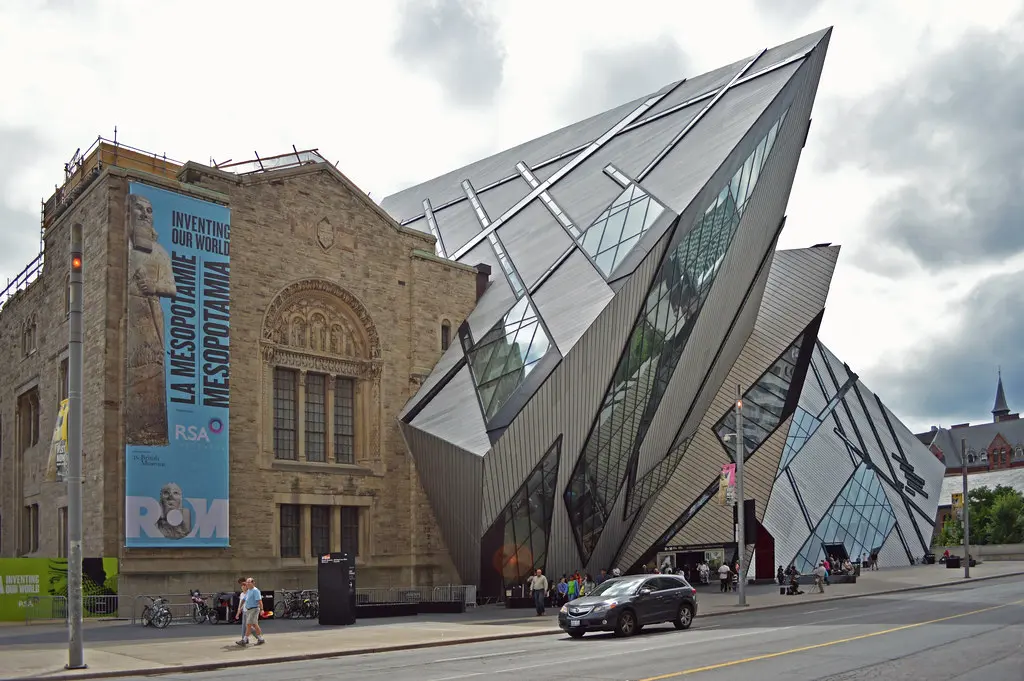
Inside, galleries span natural history, world cultures, fine art, and archaeology. Visitors can explore exhibits ranging from ancient Egyptian artifacts to Indigenous Canadian art to dinosaur skeletons.
Temporary exhibitions ensure there’s always something new on display, while family-friendly programs and educational workshops enhance the experience for younger audiences. Located in the heart of Toronto, the museum is easily accessible by public transit and close to other cultural institutions like the Gardiner Museum and Queen’s Park.
10. Niagara-on-the-Lake
Important Information
- Address: Town of Niagara-on-the-Lake, about 20 km north of Niagara Falls
- Parking: Paid street parking in historic district; free lots near Queen’s Royal Park
- Accessibility: Historic town with cobblestone streets — mostly accessible but some older shops may have steps
- Opening/Closing Time: Year-round destination; shops 10 am – 6 pm; peak season May–October
- Distance to City Centre: About 90 minutes from Toronto by car
- Type of Experience: Heritage town known for wineries, boutique shopping, and the Shaw Festival Theatre
- Special Notes: Picturesque streets, horse-drawn carriages, and seasonal flower displays
- Family Friendly?: Yes — plenty of walking, dining, and cultural options for all ages
- Insider Tip: Visit mid-spring or early fall for mild weather and smaller crowds
- Why Good for Your Guide: Offers an elegant, romantic escape — the soft side of Ontario travel
Often overshadowed by the waterfalls just down the road, Niagara-on-the-Lake offers a quieter, more refined alternative in the same region. This well-preserved town blends 19th-century charm with a thriving food and wine scene. Visitors walk down tree-lined streets, browse independent shops, and take in historic architecture that dates back more than two centuries.

Among the many attractions, this town stands out for its proximity to over 20 wineries, many of which offer tastings and vineyard tours. It’s also home to the Shaw Festival, one of North America’s most respected theatre companies. While some travelers come for a day trip, it’s worth staying longer to explore the countryside by bike or enjoy an evening by Lake Ontario.
If you're making a list of what to do in Niagara Falls, it’s worth extending your itinerary to include Niagara-on-the-Lake. The drive is short, but the atmosphere is completely different—calm, walkable, and steeped in heritage.
11. National Gallery of Canada
Important Information
- Address: 380 Sussex Drive, Ottawa, ON K1N 9N4
- Parking: Underground paid parking available on-site; accessible from St. Patrick Street
- Accessibility: Fully accessible, elevators throughout, assistive listening devices, and barrier-free washrooms
- Opening/Closing Time: Wednesday–Monday, 10 am – 5 pm (closed Tuesdays); Thursdays extended to 8 pm
- Distance to City Centre: Located in downtown Ottawa, a short walk from Parliament Hill
- Type of Experience: Canada’s national art museum — features Indigenous, Canadian, and international works
- Special Notes: Home to the iconic “Maman” spider sculpture and panoramic views of the Ottawa River
- Family Friendly?: Yes — activity guides available for kids and youth workshops
- Insider Tip: Visit early morning or late afternoon to enjoy galleries with fewer crowds; don’t miss the glass Great Hall
- Why Good for Your Guide: Adds a cultural and architectural gem, connecting art to Canada’s national identity
For visitors interested in Ottawa, the National Gallery of Canada offers a comprehensive overview of the country's artistic evolution. The building itself is striking—sharp lines, glass façades, and panoramic views of the Ottawa River. Inside, the collection spans centuries, with Canadian, Indigenous, and European works presented in a space that encourages quiet reflection.
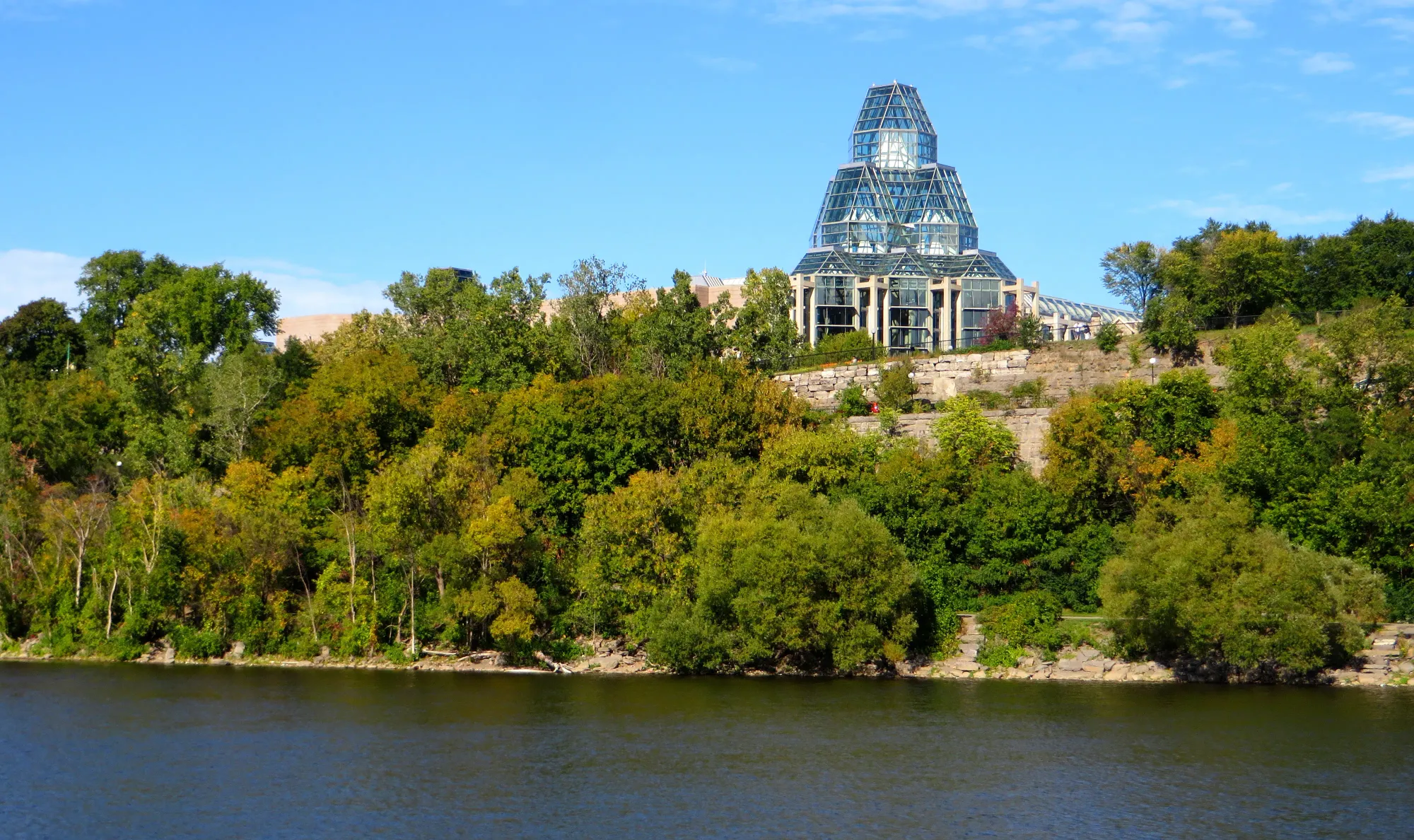
The gallery’s layout balances permanent exhibits with rotating installations, offering both historical grounding and contemporary relevance. One of the highlights is the Indigenous and Inuit art section, which presents deeply rooted traditions alongside modern interpretations. Internationally recognized artists such as Van Gogh, Monet, and Picasso are also represented, giving the space global depth.
Visitors can also enjoy the adjacent outdoor sculpture garden and explore nearby cultural landmarks, including the ByWard Market and Notre-Dame Cathedral. The gallery is a short walk from Parliament Hill and is accessible by public transit.
12. Muskoka Lakes Region
Important Information
- Address: Encompasses towns such as Bracebridge, Gravenhurst, Port Carling, and Bala, ON
- Parking: Free parking widely available at public beaches, marinas, and town centres
- Accessibility: Many resorts and trails are accessible; check individual accommodations for facilities
- Opening/Closing Time: Year-round destination; peak season June–September for lake activities
- Distance to City Centre: About 2 hours north of Toronto by car via Highway 400/11
- Type of Experience: Lakeside escape — boating, cottage stays, hiking, and scenic drives
- Special Notes: Known as “The Hamptons of the North”; popular for luxury lodges and summer getaways
- Family Friendly?: Absolutely — wide range of outdoor and water-based activities for all ages
- Insider Tip: Visit in fall for stunning foliage and fewer crowds; take the steamship cruise from Gravenhurst
- Why Good for Your Guide: Represents Ontario’s laid-back, nature-focused lifestyle — ideal for “slow travel” storytelling
Muskoka Lakes represent the classic Canadian summer experience. This region is known for its clear lakes, pine-covered shorelines, and a network of towns that manage to stay charming without becoming overly commercial. Visitors can stay in lakeside cottages, explore public beaches, or simply watch the sunset from a dock with a coffee or glass of wine in hand.
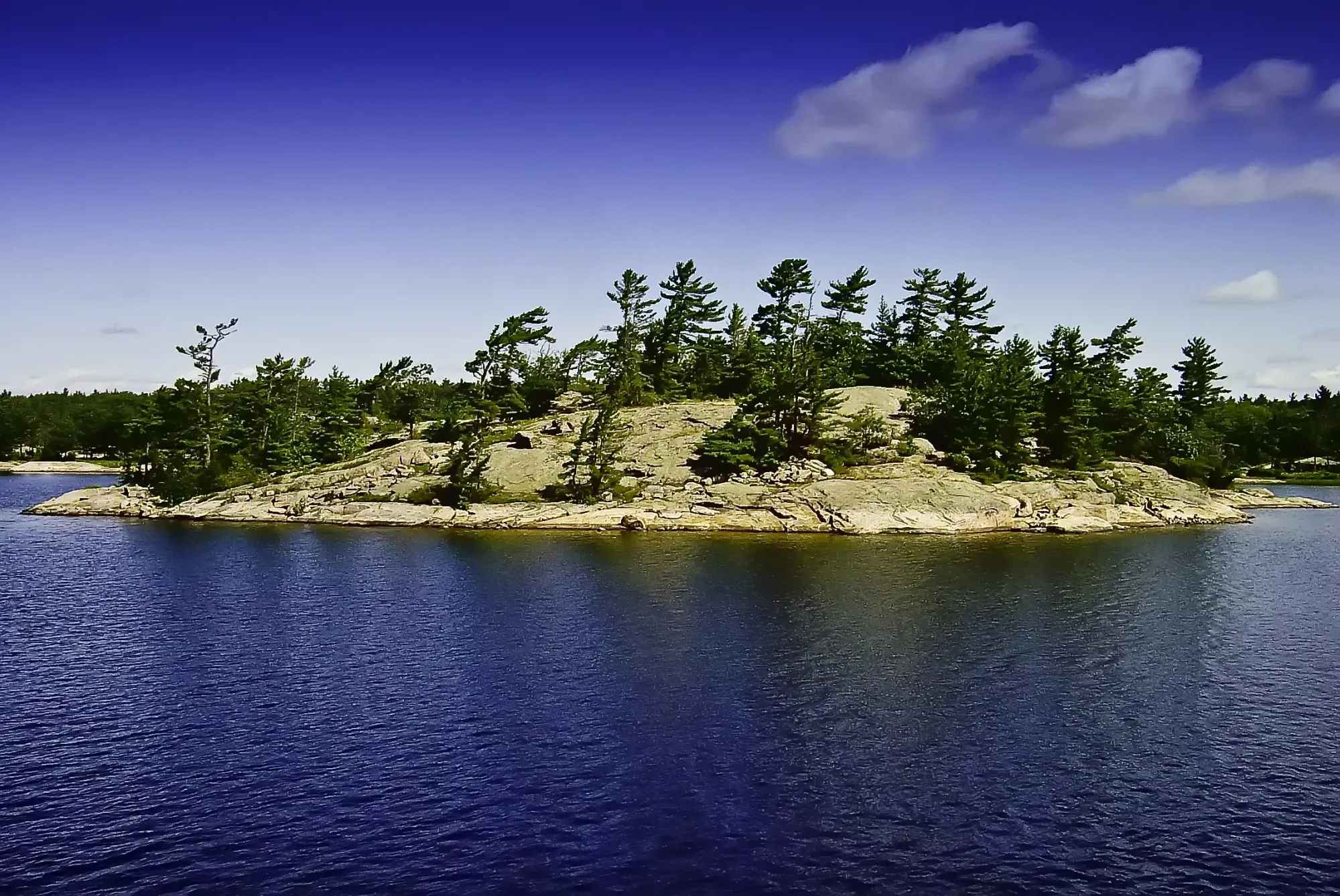
If you’re building a list of places to go for rest and recharge, Muskoka belongs at the top. It’s ideal for boating, paddling, fishing, and hiking, with trails and water routes that vary in difficulty and accessibility. Port Carling, Bracebridge, and Gravenhurst serve as local hubs offering small-town dining, local markets, and arts festivals throughout the warmer months.
13. Point Pelee National Park
Important Information
- Address: 1118 Point Pelee Drive, Leamington, ON N8H 3V4
- Parking: Multiple parking lots near the visitor centre, boardwalk, and tip shuttle area
- Accessibility: Wheelchair-accessible boardwalks, shuttle, and visitor facilities; beach access may vary
- Opening/Closing Time: Year-round; visitor centre typically open 9 am – 5 pm; extended hours in summer
- Distance to City Centre: About 60 km southeast of Windsor; ~3.5 hours from Toronto
- Type of Experience: Canada’s southernmost national park — marshes, migratory birds, and unique ecosystems
- Special Notes: A prime birdwatching and monarch butterfly migration site in spring and fall
- Family Friendly?: Yes — stroller-friendly trails and educational programs available
- Insider Tip: Bring binoculars for birding; arrive early for sunrise views at “The Tip” — mainland Canada’s southernmost point
- Why Good for Your Guide: Adds a biodiverse and symbolic edge to Ontario travel — the literal “end of Canada”
Point Pelee National Park is a significant ecological site located along the north shore of Lake Erie. It's most famous for its role in seasonal bird migrations, drawing birdwatchers from around the world every spring and fall. But it offers far more than binoculars and checklists—it’s a peaceful, well-maintained park with trails, boardwalks, and a panoramic viewing platform that extends into the lake.
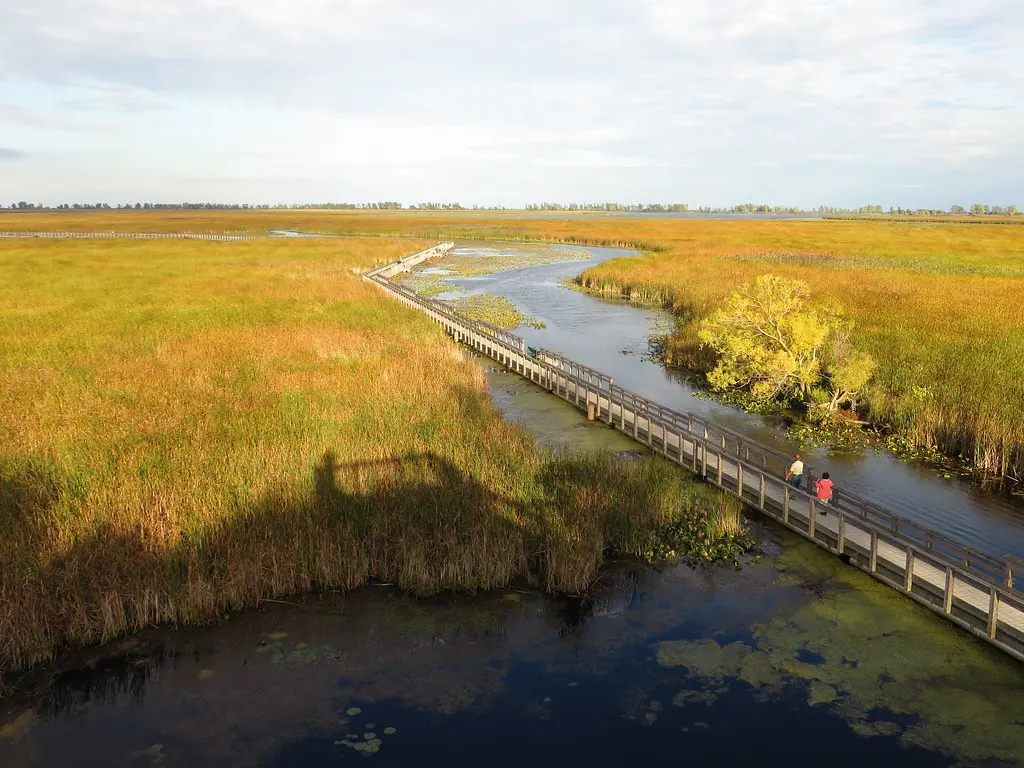
Point Pelee stands out for its quiet beauty and accessible natural features. It’s a relatively compact park, making it ideal for half-day visits or short overnight stays. Canoeing through the marsh, biking along the park roads, and walking the Tip Trail are all popular activities.
The park also holds cultural importance, with interpretive programs that explore Indigenous history and local ecology. During peak migration seasons, the visitor centre offers guides, workshops, and family-friendly educational experiences.
Point Pelee is an excellent choice. Its location also makes it easy to combine with visits to Windsor, Pelee Island, or other destinations along Lake Erie.
⭐⭐⭐⭐⭐ - Pranali Patel
Point Pelee National Park is a beautiful gem! The park offers stunning landscapes, from the wetlands to the forest trails, and the views at the point are incredible. I especially loved the birdwatching opportunities, as the park is a prime spot for migratory birds. The trails are well-maintained, and the staff was friendly and informative. The visitor center is a nice touch, with helpful exhibits and a small gift shop.
Overall, it’s a peaceful and scenic park that’s definitely worth a visit, especially if you love nature and wildlife. Would highly recommend!
14. Kingston Penitentiary Tour
Important Information
- Address: 560 King Street West, Kingston, ON K7L 4V7
- Parking: Paid parking available at the site and nearby Kingston waterfront
- Accessibility: Historic site with partial accessibility; uneven surfaces in some areas
- Opening/Closing Time: Seasonal, typically May–October; tours run 9 am – 5 pm daily
- Distance to City Centre: 2 km from downtown Kingston
- Type of Experience: Guided tour of Canada’s oldest maximum-security prison (1835–2013)
- Special Notes: Insightful and eerie — former cells, stories of inmates, and reform history
- Family Friendly?: Recommended for ages 12+ due to mature subject matter
- Insider Tip: Book early — tours sell out weeks in advance; guided by former correctional officers
- Why Good for Your Guide: Combines dark history with strong storytelling potential — authentic, thought-provoking Ontario heritage
The Kingston Penitentiary is a rare example of a historic site that blends architecture, criminology, and real human stories into one guided experience. Once one of the oldest operating prisons in Canada, it now offers public tours that provide a firsthand look into the country’s evolving justice system.

These tours are led by former staff and correctional officers, adding depth to the narrative as you move through cell blocks, segregation units, and the once heavily guarded exercise yard. Photography is encouraged, but the most memorable moments often come from hearing about the daily lives of inmates and the real stories behind the stone walls.
It’s not a reenactment or a dramatized version of history—it’s an honest look at the institution's role in Canadian society over nearly two centuries. Combined with a walk around Kingston’s waterfront or a visit to nearby Fort Henry, it gives travelers a broader sense of the city’s strategic and social history.
15. Sleeping Giant Provincial Park
Important Information
- Address: Highway 587, Pass Lake, ON P0T 2M0
- Parking: Free day-use parking at trailheads and visitor areas
- Accessibility: Visitor centre and select trails accessible; terrain in backcountry is rugged
- Opening/Closing Time: Open year-round; camping and services mainly May–October
- Distance to City Centre: About 40 km east of Thunder Bay (40–45 minutes by car)
- Type of Experience: Dramatic cliffs, boreal forest hikes, Lake Superior views, and geological formations
- Special Notes: Named after a formation resembling a giant lying on his back; features the famous Top of the Giant Trail
- Family Friendly?: Yes for day hikes and camping, though some trails are advanced
- Insider Tip: Start the Top of the Giant hike early; it’s ~22 km roundtrip but offers one of Ontario’s most stunning viewpoints
- Why Good for Your Guide: Captures Ontario’s wild northern spirit — solitude, scale, and raw beauty
Sleeping Giant Provincial Park offers over 100 kilometers of hiking trails along the Sibley Peninsula, making it a top destination for outdoor travelers in Northern Ontario. Its varied terrain includes dense forest, cliffs, and panoramic lookouts, with the Top of the Giant trail being the most rewarding—and physically demanding—route.
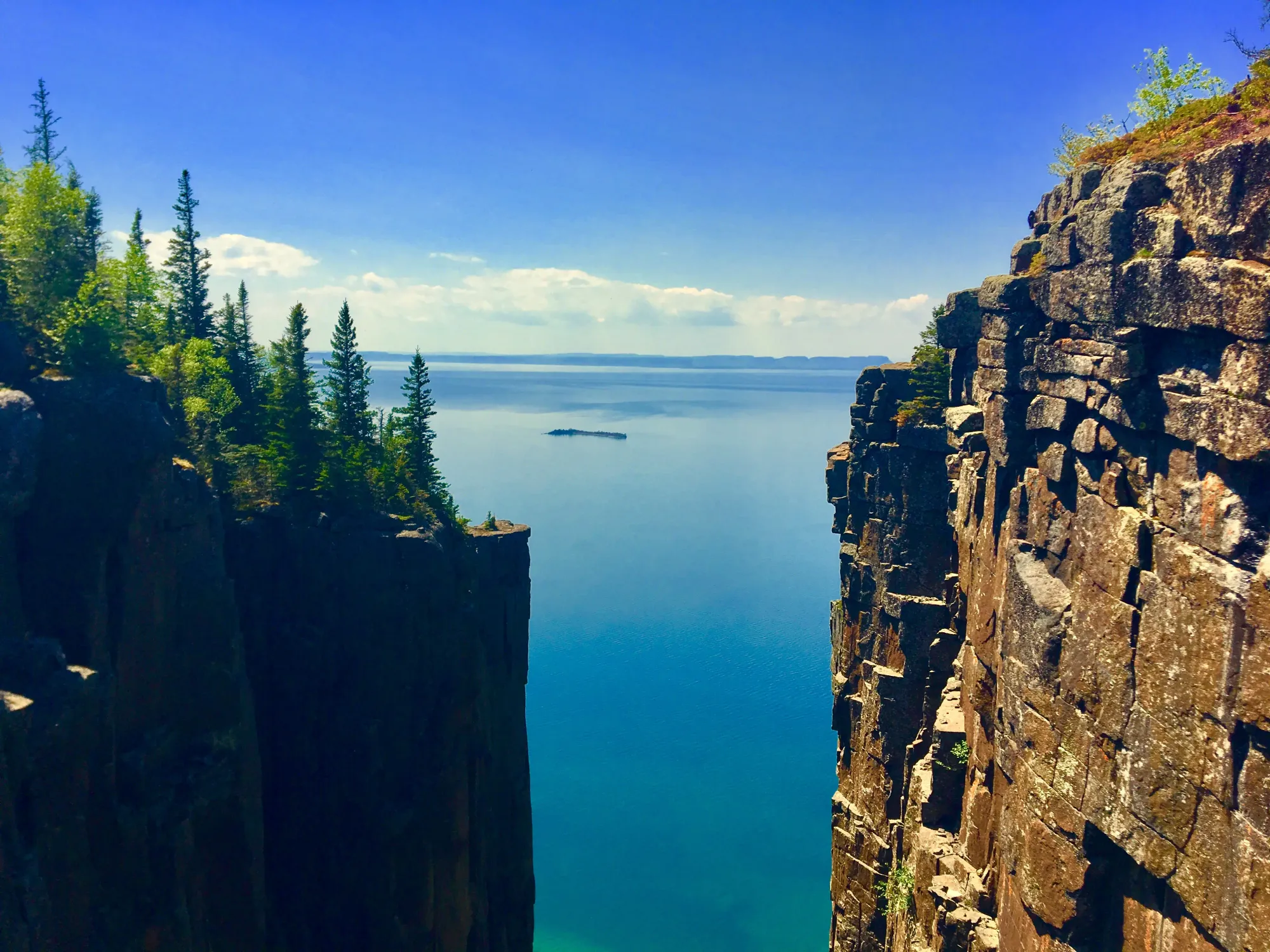
The park is part of the boreal ecosystem, home to moose, foxes, and over 200 species of birds. From spring through fall, it's ideal for hiking and kayaking; in winter, snowshoeing and cross-country skiing take over. With camping options and rustic cabins available, it also works well for longer stays.
Unlike more crowded natural attractions in Southern Ontario, Sleeping Giant offers space to explore without interruption. It’s also deeply connected to Indigenous legends and local history, which are shared at the visitor center and interpretive areas throughout the park.
⭐⭐⭐⭐⭐ - J LA
An experience to remember, like no other 🙌
We did the Top of the Giant trail - 1 adult, 3 kids (11 -15). We are fairly experienced hikers and did not find the trail overly challenging but would highly recommended good footwear and long pants/sleeves and or bug spray. The views from the top are surreal. We completed the hike in just over 5 hours - walking at a steady pace. On the way out of the park (around dusk) we saw a few deer 🦌 and a fox 🦊. A wonderful day at Sleeping Giant Provincial Park!!
16. Art Gallery of Ontario (AGO)
Important Information
- Address: 317 Dundas Street West, Toronto, ON M5T 1G4
- Parking: Paid underground parking at Dundas & McCaul Streets; public transit stops nearby
- Accessibility: Fully accessible building; elevators, ramps, and barrier-free washrooms throughout
- Opening/Closing Time: Tuesday–Sunday 10:30 am – 5 pm; extended to 9 pm on Wednesdays and Fridays; closed Mondays
- Distance to City Centre: In the heart of downtown Toronto, near Chinatown and the University of Toronto
- Type of Experience: One of North America’s largest art museums — over 90,000 works from Canada and beyond
- Special Notes: Frank Gehry’s striking architectural redesign blends heritage and modernism beautifully
- Family Friendly?: Yes — family activity guides and children’s workshops available
- Insider Tip: Visit early or mid-afternoon for quieter galleries; free admission on Wednesday evenings
- Why Good for Your Guide: Highlights Ontario’s artistic and architectural sophistication, balancing natural attractions with culture
The Art Gallery of Ontario (AGO) is one of Canada’s most important art institutions, housing more than 90,000 works across its permanent collection. From the Canadian Group of Seven to African, Indigenous, and European art, the gallery presents a wide lens on global creativity while maintaining a strong national identity.
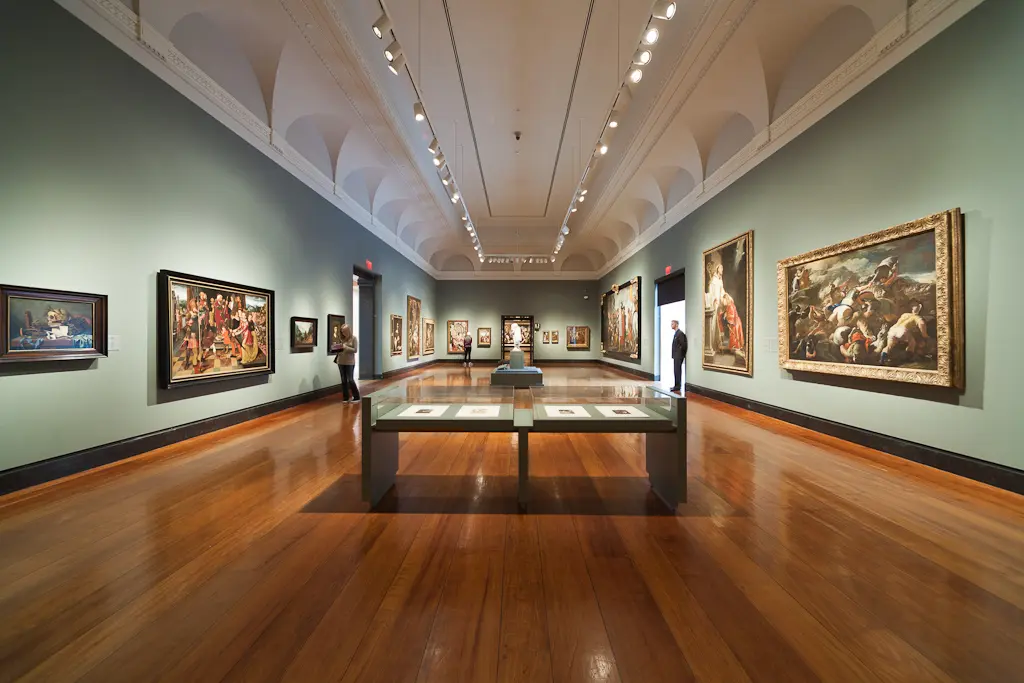
The gallery is thoughtfully laid out, with temporary exhibitions rotating through themes like architecture, photography, and modern design. It's a strong pick for travelers exploring Toronto with a focus on culture, as it offers both depth and variety. The AGO is also known for its contemporary exhibitions that spotlight underrepresented voices, making it as relevant as it is historic.
Facilities include a café, reading lounges, and learning centers that regularly host artist talks and public events. Located in the Grange Park neighborhood, it's walking distance from other attractions like the University of Toronto, OCAD University, and the Gardiner Museum.
17. Whirlpool Aero Car
Important Information
- Address: 3850 Niagara Parkway, Niagara Falls, ON L2E 3E8
- Parking: Free on-site parking adjacent to the attraction
- Accessibility: Limited; steep access path and steps — not suitable for wheelchairs
- Opening/Closing Time: Seasonal operation (April – November), typically 9 am – 6 pm
- Distance to City Centre: About 5 km north of central Niagara Falls
- Type of Experience: Suspended cable car ride offering bird’s-eye views of the Niagara Whirlpool and Gorge
- Special Notes: Built in 1916 — a century-old engineering marvel still in operation today
- Family Friendly?: Yes for most ages; children under 5 must be accompanied by an adult
- Insider Tip: Go on a clear morning for best photos; bring a light jacket — it’s breezy over the gorge
- Why Good for Your Guide: Unique historic attraction with breathtaking perspectives — great for adventure or engineering-curious audiences
The Whirlpool Aero Car offers a unique view of the Niagara River that most visitors to the falls miss entirely. Suspended on six cables above the swirling Niagara Whirlpool, this antique cable car travels between two points on the Canadian side, offering unobstructed views of the water below and the surrounding gorge.
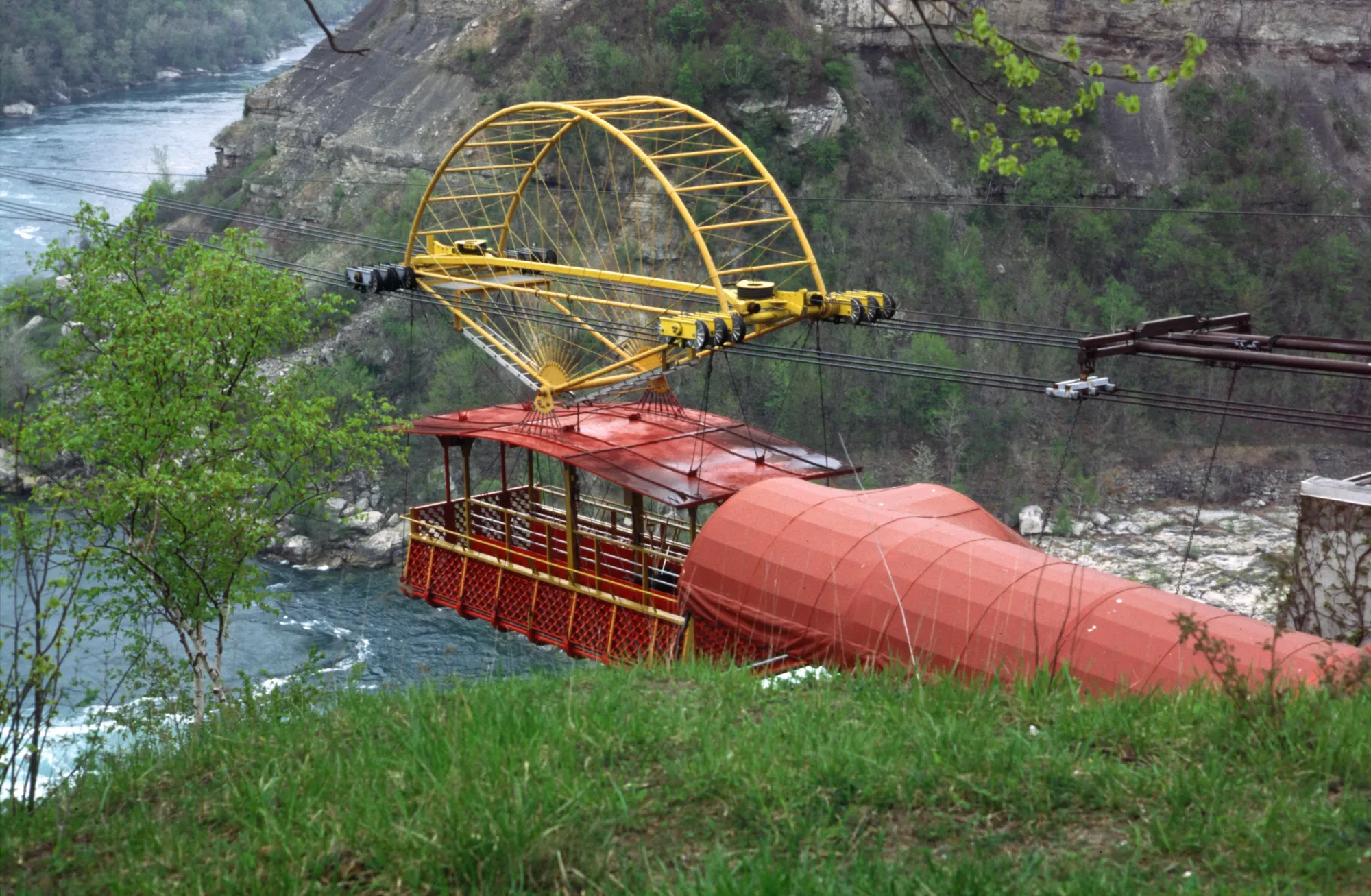
It’s a quiet, 10-minute ride that feels more contemplative than thrilling, though the height and movement over the whirlpool can definitely raise your heart rate. On clear days, you can see far up the river, and the contrasting colors of the water below, especially when the whirlpool is active, are striking.
While it’s often overshadowed by more modern installations, the Aero Car remains an enduring symbol of how Niagara blends engineering with natural spectacle. It's also included in some Niagara Falls attraction ticket bundles, so it’s smart to plan ahead if you want to maximize your visit without rushing.
⭐⭐⭐⭐⭐ - Faustine D'Elia
this was a beautiful attraction, i got the 2 adult package on the website and it made it a bit cheaper! the views were gorgeous and the tour guide in the aero car was entertaining, funny and kind. the car takes up to 10 min total to complete and it’s very smooth! the attraction closes around the end of november for those wondering 🙂
18. Rideau Canal
Important Information
- Address: Extends 202 km from Ottawa to Kingston; main downtown access at Rideau Street near Parliament Hill
- Parking: Paid lots along the canal (notably at Dows Lake Pavilion and Bytown Museum)
- Accessibility: Paved walkways and cycling paths; skating sections accessible via ramps during winter
- Opening/Closing Time: Open year-round; skating season usually January – February (weather-dependent)
- Distance to City Centre: Runs directly through central Ottawa — easily reached on foot
- Type of Experience: UNESCO World Heritage Site — boating in summer, world’s largest skating rink in winter
- Special Notes: Built in 1832; blends engineering heritage, recreation, and scenic beauty
- Family Friendly?: Yes — safe, family-oriented environment for walking, biking, and skating
- Insider Tip: Rent a canoe or bike in summer; in winter, skate at night for magical atmosphere under city lights
- Why Good for Your Guide: Embodies “Canadian lifestyle” charm — outdoor recreation meets historic elegance
The Rideau Canal winds its way through downtown Ottawa and into the countryside beyond, offering visitors a unique way to experience Canada's capital in every season. In summer, the canal comes alive with paddlers, cyclists, and walkers. Kayak and canoe rentals are widely available, making it easy to navigate stretches of the waterway lined by historic buildings, parks, and gardens.
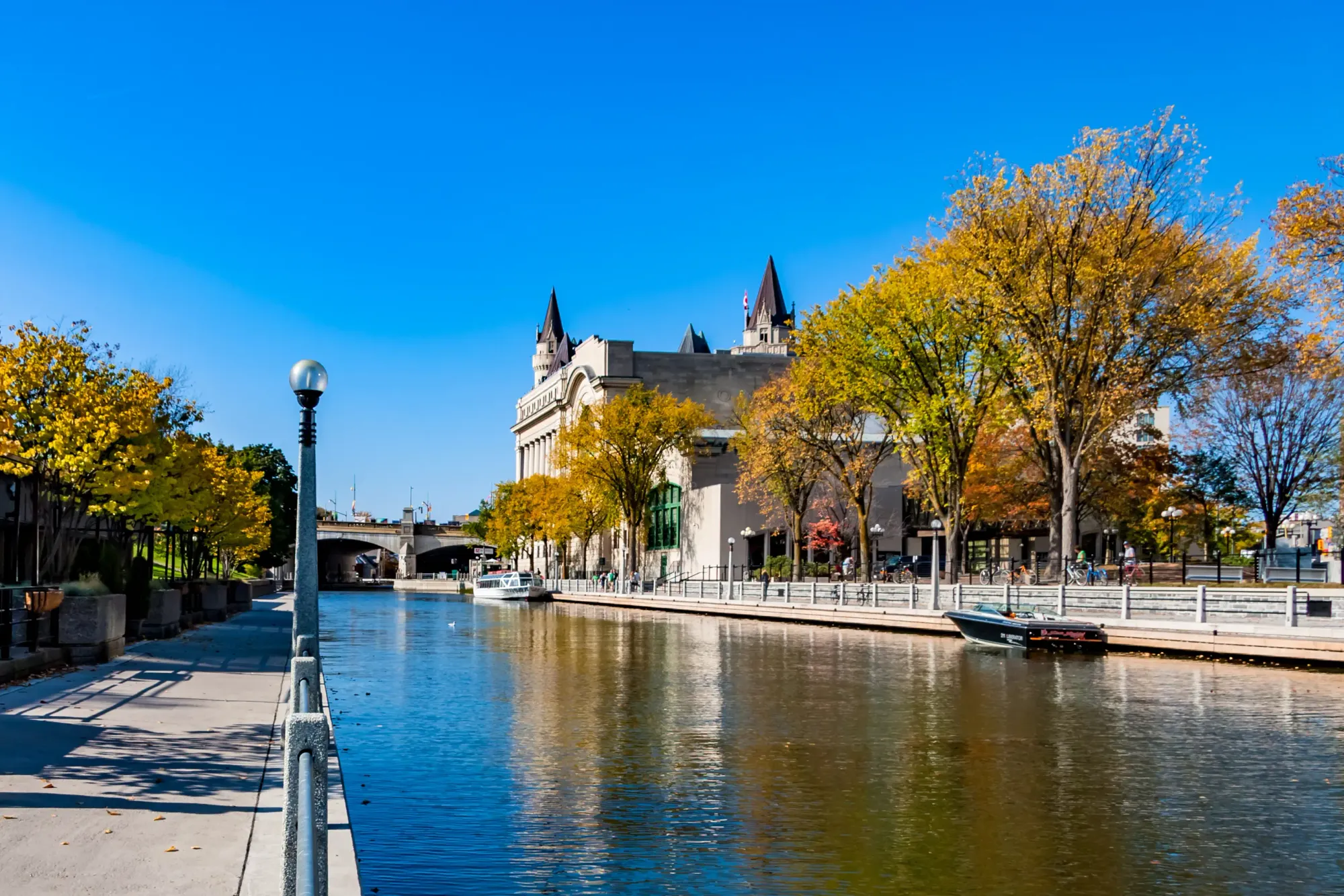
When the temperature drops, the canal transforms into the world’s largest skating rink, stretching nearly eight kilometers. During the winter months, skating on the Rideau Canal is a signature experience, complete with warming huts and food vendors selling hot chocolate and BeaverTails.
The canal is more than a recreational space; it’s a historic engineering achievement, built in the early 19th century to secure a military supply route. Interpretive signs and guided tours provide context for its strategic importance.
19. Blue Mountain Resort
Important Information
- Parking: Free and paid parking at base lodges and village areas
- Accessibility: Accessible accommodation and gondola access to scenic lookout for most visitors
- Opening/Closing Time: Open year-round; skiing December – March, mountain adventures spring – fall
- Distance to City Centre: About 11 km from Collingwood; ~2 hours north of Toronto
- Type of Experience: Ontario’s premier four-season mountain resort — skiing, biking, zip-lining, spa, and dining
- Special Notes: Vibrant pedestrian village with shops, restaurants, and festivals year-round
- Family Friendly?: Yes — programs for kids, families, and couples alike
- Insider Tip: Book weekday stays for lower rates and quieter slopes; sunset gondola rides are stunning
- Why Good for Your Guide: Showcases Ontario’s alpine spirit — active, social, and scenic
Blue Mountain Resort is often associated with skiing and snowboarding, but it has evolved into a true four-season destination. During winter, the resort's 43 trails and multiple terrain parks offer varied options for all skill levels. Come summer, the mountain transforms into a hub for hiking, mountain biking, zip-lining, and golf.
The Village at Blue Mountain offers shops, restaurants, and festivals throughout the year. Nearby Scandinave Spa is a popular choice for travelers looking to unwind after a day of outdoor activity, with its hot and cold baths set against a forest backdrop.

⭐⭐⭐⭐⭐ - Manan Pandya
Our stay at Blue Mountain Resort and the Village Suites was absolutely delightful! The resort was pleasantly uncrowded, allowing us to unwind and enjoy our time. The weather was ideal, and there were plenty of exciting activities for all ages. We appreciated how well-organized everything was, from the scenic gondola ride to the mini golf and activity centre, buying the day pass was worth it as all the activities are covered under it. We had so much fun. The staff were warm and welcoming.
20. Royal Botanical Gardens in Burlington
Important Information
- Address: 680 Plains Road West, Burlington, ON L7T 4H4
- Parking: Multiple on-site parking lots across the five garden areas
- Accessibility: Fully accessible trails, shuttles, and visitor facilities; mobility aids available
- Opening/Closing Time: Daily 10 am – 8 pm (seasonal hours in winter)
- Distance to City Centre: Roughly 60 km west of Toronto (about 45 min by car)
- Type of Experience: Canada’s largest botanical garden — 2,700 acres of gardens, trails, and wetlands
- Special Notes: Divided into themed gardens (Hendrie Park, Rock Garden, Arboretum, and more)
- Family Friendly?: Yes — children’s garden programs and nature trails available
- Insider Tip: Visit late May–June for peak blooms; bring insect repellent if exploring forest trails
- Why Good for Your Guide: Blends horticulture, conservation, and serenity — ideal finale for your Ontario travel sequence
The Royal Botanical Gardens (RBG) is Canada's largest botanical garden and one of the most significant in North America. Spanning across Burlington and Hamilton, it blends formal gardens, arboretums, and nature sanctuaries into a comprehensive outdoor experience. Visitors can explore themed gardens, seasonal floral displays, and an extensive network of trails leading through wetlands, forests, and fields.
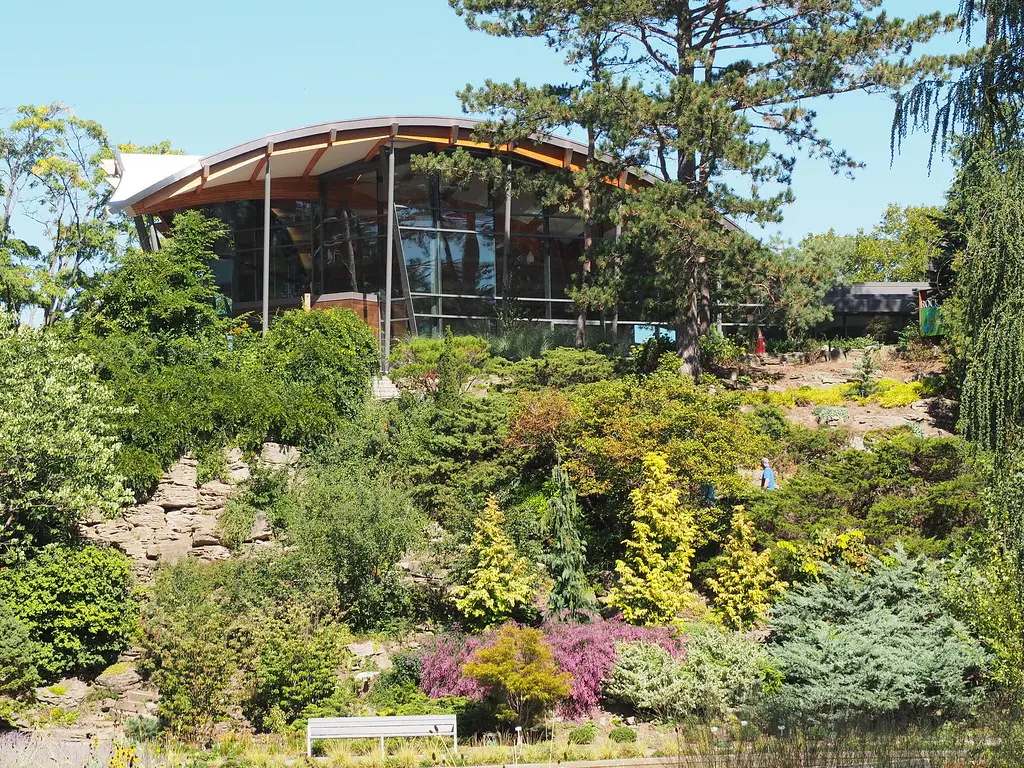
RBG is especially known for its lilac, rose, and iris collections. The gardens are carefully curated to offer color and interest through all four seasons, with special events such as plant sales, photography workshops, and educational exhibits enriching the experience.
Beyond horticulture, the RBG is a center for ecological conservation and public education. Visitors can join guided walks, birdwatching sessions, or children’s programming focused on sustainability. The combination of curated garden spaces and preserved natural areas allows visitors to experience both beauty and biodiversity in one location. A trip to the RBG can easily complement visits to nearby attractions in Burlington and Hamilton, making it an ideal stop on a Southern Ontario itinerary.
21. Thousand Islands by Boat
Important Information
- Address: 122 Big Nickel Mine Drive, Sudbury, ON P3C 5T7
- Parking: Free on-site parking adjacent to the entrance
- Accessibility: Fully accessible exhibits, elevator access, and tactile learning spaces
- Opening/Closing Time: Typically open March – November, 10 am – 5 pm daily (check winter schedule)
- Distance to City Centre: About 4 km southwest of downtown Sudbury
- Type of Experience: Interactive earth sciences museum featuring geology exhibits, mining tours, and the famous “Big Nickel” monument
- Special Notes: The underground mine tour (guided) is a must-see — wear closed shoes and light jacket
- Family Friendly?: Yes — designed for children and families interested in science and engineering
- Insider Tip: Buy combo tickets with Science North for full-day exploration and discounts
- Why Good for Your Guide: Adds educational, experiential depth — connects Ontario’s mining heritage with family-friendly fun
A Thousand Islands boat tour is the most immersive way to experience this stunning archipelago straddling the Canadian and U.S. border. Departing from Gananoque, tours vary from quick scenic cruises to extended trips that navigate deeper into the island chain. On clear days, visitors can see dozens of islands—some no bigger than a backyard, others home to historic mansions and lighthouses.
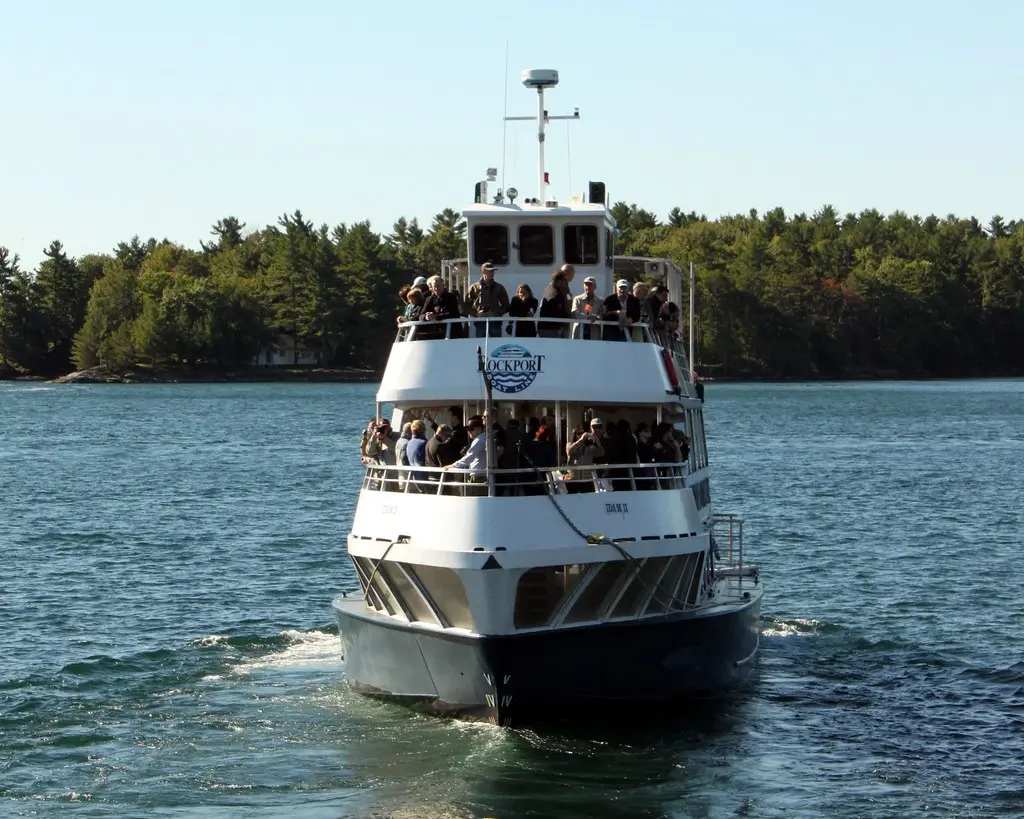
The views are expansive and constantly shifting, offering glimpses of private cottages, remote beaches, and castle ruins. Some tours include commentary on the region’s history, geography, and smuggling lore from the Prohibition era.
22. Sudbury’s Dynamic Earth Science Centre
Important Information
- Address: 122 Big Nickel Mine Drive, Sudbury, ON P3C 5T7
- Parking: Free on-site parking adjacent to the entrance
- Accessibility: Fully accessible exhibits, elevator access, and tactile learning spaces
- Opening/Closing Time: Typically open March – November, 10 am – 5 pm daily (check winter schedule)
- Distance to City Centre: About 4 km southwest of downtown Sudbury
- Type of Experience: Interactive earth sciences museum featuring geology exhibits, mining tours, and the famous “Big Nickel” monument
- Special Notes: The underground mine tour (guided) is a must-see — wear closed shoes and light jacket
- Family Friendly?: Yes — designed for children and families interested in science and engineering
- Insider Tip: Buy combo tickets with Science North for full-day exploration and discounts
- Why Good for Your Guide: Adds educational, experiential depth — connects Ontario’s mining heritage with family-friendly fun
Dynamic Earth in Sudbury is a hands-on science center with a strong focus on geology, mining, and earth sciences. Operated by Science North, this facility dives deeper into Northern Ontario’s mining legacy while offering interactive exhibits that appeal to all ages. Visitors can descend into a simulated underground mine tour, explore real mining equipment, and see how minerals are used in everyday life.

The exhibits cover more than just mining—they highlight sustainable technologies, environmental restoration, and the broader science of the planet beneath our feet.
Outside, the grounds include walking trails and the famous Big Nickel, making it an easy place to spend a few hours. It’s also suitable for school groups, solo travelers, and families alike. As part of Sudbury’s broader science and education landscape, Dynamic Earth helps visitors understand the region’s geological identity and how it connects to Canada's natural and industrial history.
23. Toronto Islands
Important Information
- Address: Accessible via Jack Layton Ferry Terminal, 9 Queens Quay West, Toronto, ON M5J 2H3
- Parking: Limited downtown parking near the ferry terminal; best reached via TTC or walking
- Accessibility: Ferries and Centre Island are wheelchair accessible; paved paths and beach ramps available
- Opening/Closing Time: Open year-round; ferries run daily 8 am – 11 pm (reduced winter service)
- Distance to City Centre: 15-minute ferry ride from downtown Toronto
- Type of Experience: Chain of small islands with beaches, bike trails, gardens, and skyline views
- Special Notes: Home to Centreville Amusement Park (summer only) and peaceful car-free recreation areas
- Family Friendly?: Yes — ideal for picnics, cycling, kayaking, and family outings
- Insider Tip: Visit early morning for quiet beaches or sunset for iconic city skyline shots; bring a picnic
- Why Good for Your Guide: Balances Toronto’s urban energy with serenity — the city’s built-in nature escape
The Toronto Islands offer a quiet contrast to the city skyline just across the water. Located a short ferry ride from downtown, the islands consist of several connected land masses, including Centre Island, Ward’s Island, and Hanlan’s Point. Once there, visitors find walking trails, beaches, gardens, and open green spaces ideal for cycling or a slow-paced afternoon.
The islands provide a flexible, low-cost outing suitable for families, couples, or solo travelers. You can rent bikes or bring your own, visit the small amusement park in the summer, or just relax by the shoreline with a picnic. The islands are also home to a small but vibrant year-round community, with a handful of cafes and local art installations tucked between residences and parkland.
The ferry ride itself offers striking views of the downtown skyline, especially at sunset. Because of their proximity and variety, the islands are often recommended to first-time visitors. The experience involves a change of pace from the urban core.
It’s an easy half-day trip that doesn’t require a car or much planning, just comfortable shoes and a curiosity for exploring Toronto’s softer side.
Conclusion
Ontario offers more than just variety — it offers balance. Across cities, small towns, and vast protected landscapes, the province makes it easy to shift between cultural depth and natural quiet. You can move from a gallery in downtown Toronto to a paddle through Algonquin’s still waters within a few hours. And that’s what makes traveling here so appealing: everything feels connected, yet distinct.
This guide highlighted a range of experiences — from remote hikes to world-class museums, quiet lakeside towns to dynamic festivals — and yet, it only scratches the surface. That’s the nature of Ontario. There’s always more to see, more context to learn, and more corners that offer something unexpected.
Planning to visit the city? Karta has some amazing deals on Ontario vacation rentals for you.
FAQ
1. What are the best months to visit Ontario?
The best time to visit Ontario depends on your interests. May through October offers the most flexibility for outdoor activities like hiking, canoeing, and exploring small towns. Fall (late September to mid-October) is especially popular for its foliage. Winter (December–March) is ideal for skiing, skating on the Rideau Canal, and visiting Ontario’s holiday markets. Cities like Toronto and Ottawa remain active year-round, while summer is the peak season for lakeside destinations like Muskoka and the Thousand Islands. If you prefer fewer crowds and lower prices, consider late spring or early fall when the weather is still pleasant but quieter.
2. How far is Niagara Falls from Toronto?
Niagara Falls is approximately 130 kilometers (about 80 miles) from downtown Toronto. By car, the drive typically takes 1.5 to 2 hours, depending on traffic. Regular train and bus services also operate between the two cities, with the train taking around two hours. Some day tours are available if you don’t want to plan transportation yourself. It’s a very manageable day trip, though many visitors choose to stay overnight to explore additional attractions like Niagara-on-the-Lake, local wineries, or the Whirlpool Aero Car. The route itself is scenic, passing through Ontario’s Golden Horseshoe region.
3. Is Ontario a good destination for families?
Yes, Ontario is one of the most family-friendly regions in Canada. Cities like Toronto, Ottawa, and Sudbury offer science centres, zoos, museums, and parks that cater to all ages. Natural areas like Algonquin Provincial Park or the Muskoka Lakes provide safe, accessible outdoor experiences like canoeing, wildlife spotting, and hiking. Many destinations, such as the Toronto Islands or Royal Botanical Gardens, are walkable and stroller-friendly. Seasonal events — from winter light festivals to summer fairs — offer engaging options year-round. Lodging, transit, and restaurants across the province are generally welcoming and well-equipped for families with young children.
4. What’s the best way to get around Ontario?
Getting around Ontario depends on your itinerary. In major cities like Toronto and Ottawa, public transit is reliable and efficient, with options like buses, subways, and light rail. For regional travel, renting a car offers the most flexibility, especially for exploring natural parks, smaller towns, and lake regions like Muskoka or Prince Edward County. Intercity train service (VIA Rail) connects Toronto, Ottawa, Kingston, and other urban hubs, while regional airports support travel to Northern Ontario. For travelers staying primarily in one city, you can rely on transit and taxis—but for rural or scenic routes, driving is best.
5. What are Ontario’s must-see natural attractions?
Ontario has a wide range of natural highlights. Niagara Falls is the most famous, but other sites are just as impactful. Algonquin Provincial Park offers iconic canoe routes and forested trails. Sleeping Giant Provincial Park near Thunder Bay delivers dramatic cliffside views over Lake Superior. Point Pelee National Park, Canada’s southernmost point, is known for bird migration and marshland trails. The Thousand Islands region offers unique boat tours among scenic islets and historic properties. If you’re visiting in autumn, the fall colors in Muskoka and along the Bruce Peninsula offer some of the best foliage views in Canada.
6. Is Ontario worth visiting in winter?
Yes, Ontario is very much a year-round destination, and winter offers experiences you won’t find elsewhere. The Rideau Canal in Ottawa becomes the world’s longest skating rink. Ski resorts like Blue Mountain and Horseshoe Valley offer snow sports just a few hours from Toronto. Cities remain lively, with museums, art galleries, indoor markets, and light festivals adding to the atmosphere. Winter is also prime time for spa visits, cozy small-town stays, and icewine tasting in Niagara. While driving conditions require more caution, winter in Ontario is scenic and calm — perfect for travelers who prefer quiet, uncrowded destinations.


